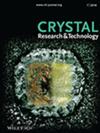陶瓷Cs2HfCl6:一种用于伽马射线光谱的新型闪烁材料
IF 1.9
4区 材料科学
Q3 CRYSTALLOGRAPHY
引用次数: 3
摘要
单晶闪烁体已经成为辐射探测器技术中最常用的材料之一。不幸的是,由于技术要求改进探测器,对更好的单晶闪烁体的研究几乎达到了极限。与单晶闪烁体相比,陶瓷具有许多优点,并已成为一种有前途的新生产工艺。最近对陶瓷闪烁体的研究主要涉及氧化物,因为它们相对容易处理并且通常不吸湿。在单晶闪烁体中,出现了一种趋势,表明在晶体结构中加入卤化物离子可以提高闪烁材料的产光率和能量分辨率,但也倾向于使材料吸湿,在某些情况下具有本质放射性。对未掺杂卤化物陶瓷闪烁体的研究很少。采用单轴热压法制备了透明卤化物Cs2HfCl6陶瓷,并对其闪烁特性与单晶进行了比较。在662 keV时,陶瓷的能量分辨率为6.4%。初步结果表明,陶瓷闪烁体是一种可行的替代方案,是闪烁体材料技术的一个有前景的新方向。本文章由计算机程序翻译,如有差异,请以英文原文为准。
Ceramic Cs2HfCl6: A Novel Scintillation Material for Use in Gamma Ray Spectroscopy
Single crystal scintillators have become one of the most common materials used in technologies that use radiation detectors. Unfortunately, as technology demands improved detectors, research into better single crystal scintillators has nearly reached its limit. Ceramics provide many benefits over single crystal scintillators and have emerged as a promising new production process. Recent research into ceramic scintillators has mostly dealt with oxides as they are relatively easy to handle and are typically non‐hygroscopic. Among single crystal scintillators, a trend has emerged indicating that the addition of halide ions into the crystal structure improves the light yield and energy resolution of the scintillation material but also tends to make the material hygroscopic and in some cases intrinsically radioactive. Little research is devoted to the investigation of undoped halide ceramic scintillators. Transparent halide Cs2HfCl6 ceramics are developed by hot uniaxial pressing, and the scintillation properties are compared to that of its single crystal counterpart. The energy resolution of the ceramic is found to be 6.4% at 662 keV. The initial results indicate that ceramic scintillators are a viable alternative and a promising new direction in scintillator material technology.
求助全文
通过发布文献求助,成功后即可免费获取论文全文。
去求助
来源期刊
自引率
6.70%
发文量
121
审稿时长
1.9 months
期刊介绍:
The journal Crystal Research and Technology is a pure online Journal (since 2012).
Crystal Research and Technology is an international journal examining all aspects of research within experimental, industrial, and theoretical crystallography. The journal covers the relevant aspects of
-crystal growth techniques and phenomena (including bulk growth, thin films)
-modern crystalline materials (e.g. smart materials, nanocrystals, quasicrystals, liquid crystals)
-industrial crystallisation
-application of crystals in materials science, electronics, data storage, and optics
-experimental, simulation and theoretical studies of the structural properties of crystals
-crystallographic computing

 求助内容:
求助内容: 应助结果提醒方式:
应助结果提醒方式:


